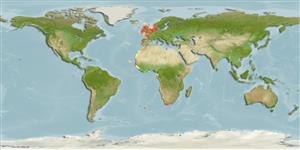Malacostraca |
Decapoda |
Majidae
Environment: milieu / climate zone / depth range / distribution range
Ecology
Benthic; depth range 0 - 80 m (Ref. 104052). Temperate
Eastern Atlantic and the Mediterranean: from the North Sea to Morocco and Bay of Biscay, extending southwards to Namibia including off lying islands.
Length at first maturity / Size / Weight / Age
Maturity: Lm 13.0 range ? - ? cm Max length : 22.0 cm CL male/unsexed; (Ref. 104052)
Maximum depth from Ref. 115714. Juveniles about to reach maturity live in shallow waters from 10 to 15 m deep on rocky and sandy substrates (Ref. 115713). They are also found on sandy bottoms colonized by Zostera marina. During summer, adults live near the shore on rocky areas. In winter, they are spotted on rocky bottoms and heterogeneous coarse sediments in deep waters. Both juveniles and adults during summer are found on muddy sands with few rocks (Ref. 115714). Uses slow, small-scale, non-directional movements. Exhibiting ontogenetic movements, juveniles live at depth of 5 to 15 m; adults then migrate to deeper waters (>50 m), where they mate (Ref. 115713). Diet remains to be accurately described. Studies (i.e. direct field observations, laboratory experiments, and gut content analyses) have suggested the species to have an omnivorous diet based on consumption of prey commonly found in their habitat (Ref. 115714). In one study, however, it was considered a mobile carnivorous species (Ref. 96498). Research using stable isotopes indicate no differences between sexes in diet or habitat use patterns either in adults (Refs. 115714, 115744) or juveniles (Refs. 115713, 115714, 115744).
Life cycle and mating behavior
Maturity | Reproduction | Spawning | Eggs | Fecundity | Larvae
Members of the order Decapoda are mostly gonochoric. Mating behavior: Precopulatory courtship ritual is common (through olfactory and tactile cues); usually indirect sperm transfer.
Le Pape, O., L. Baulier, A. Cloarec, J. Martin, F. Le Loc'h and Y. Désaunay 2007 Habitat suitability for juvenile common sole (Solea solea, L.) in the Bay of Biscay (France): a quantitative description using indicators based on epibenthic fauna. Journal of Sea Research 57:126-136. (Ref. 96498)
IUCN Red List Status
(Ref. 130435: Version 2025-1)
CITES status (Ref. 108899)
Not Evaluated
Not Evaluated
Threat to humans
Harmless
Human uses
Fisheries: commercial
| FishSource |
Tools
More information
Population dynamicsGrowthMax. ages / sizesLength-weight rel.Length-length rel.Length-frequenciesMass conversionAbundance PhysiologyOxygen consumption
Human RelatedStamps, coins, misc.
Internet sources
Estimates based on models
Resilience
High, minimum population doubling time less than 15 months (Fec=300,000).
Fishing Vulnerability
Low vulnerability (12 of 100).
